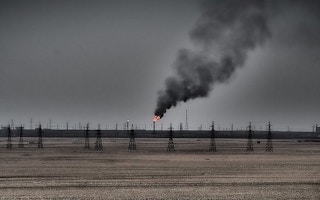Methane concentrations in the atmosphere have risen at a “dangerously fast” rate and now exceed 1,900 parts per billion, prompting some researchers to warn that climate change itself may be driving the increase.
Atmospheric methane levels are now nearly triple pre-industrial levels, a news article in the journal Nature states, citing data released last month by the US National Oceanic and Atmospheric Administration (NOAA).
“Scientists says the grim milestone underscores the importance of a pledge made at last year’s COP 26 climate summit to curb emissions of methane,” a climate pollutant that Nature cites as at least 28 times more potent than CO2, but is actually 80 to 85 times more damaging over the 20-year span when humanity will be scrambling to get the climate emergency under control.
While the research focused to some degree on methane released through microbial action, Nature says nearly two-thirds of the methane releases between 2007 and 2016 were caused by human activity.
When the Intergovernmental Panel on Climate Change (IPCC) released its latest, landmark climate science assessment in August, researchers pointed to rapid, deep methane cuts as the single most important step in stemming the rise of the greenhouse gases that cause climate change. In early November, scientists warned that the 30 per cent reduction pledge at COP 26 fell short of what was needed.
The new research shows the problem getting worse.
“The growth of methane emissions slowed around the turn of the millennium, but began a rapid and mysterious uptick around 2007,” Nature writes. “The spike has caused many researchers to worry that global warming is creating a feedback mechanism that will cause ever more methane to be released, making it even harder to rein in rising temperatures.”
The report explains the analysis scientists conduct to attribute to accurately attribute methane emissions to different sources, from microbial activity to fossil fuel production. Xin Lan, an atmospheric scientist at NOAA’s Global Monitoring Laboratory in Boulder, Colorado, said microbes account for 85 per cent of the emissions increase since 2007, with the rest due to fossil fuel production.
“Is warming feeding the warming? It’s an incredibly important question,” said Royal Holloway, University of London Earth scientist Euan Nisbet. “As yet, no answer, but it very much looks that way.”
But “regardless of how this mystery plays out, humans are not off the hook,” Nature adds. “Based on their latest analysis of the isotopic trends, Lan’s team estimates that anthropogenic sources such as livestock, agricultural waste, landfill, and fossil fuel extraction accounted for about 62 per cent of total methane emissions from 2007 to 2016.”
The Nature report last week landed just five days after new satellite imagery identified “ultra-emitters” in Turkmenistan, Russia, and the United States as the world’s biggest sources of methane leaks from oil and gas facilities, New Scientist reports. The next three biggest emitters were Iran, Algeria, and Kazakhstan.
“While huge plumes of methane leaking from gas pipelines have been detected by satellites at individual sites, such as a gas well in Ohio and several pipelines in central Turkmenistan, little has been know about their extent globally,” New Scientist explains. “Now, images captured by an instrument aboard a satellite have been run through an algorithm to automatically detect the biggest plumes of methane streaming from oil and gas facilities worldwide.”
The more than 25 tonnes of methane per hour coming from the ultra-emitters is “a heck of a lot”, US Environmental Defense Fund Chief Scientist Steve Hamburg told New Scientist climate specialist Adam Vaughan.
“Collectively, these contribute about eight million tonnes of methane a year, about a tenth of the oil and gas industry’s total annual emissions for 2019-20,” Vaughan writes.
This story was published with permission from The Energy Mix.

















